2000-2005
San Mateo County
Equal Employment
Opportunity Plan


COUNTY OF SAN MATEO
EQUAL EMPLOYMENT OPPORTUNITY PLAN
for a
Four Year Period Ending December 31, 2005
adopted by
BOARD OF SUPERVISORS
COUNTY OF SAN MATEO
MARK CHURCH RICHARD GORDON
1st District 3rd District
Supervisor Supervisor
JERRY HILL ROSE JACOBS GIBSON
2nd District 4th District
Supervisor Supervisor
________________________________________
MICHAEL NEVIN
5th District
Supervisor
Table of Contents
Page
I. PURPOSE AND RESPONSIBILITIES 1
II. POLICIES 6
III. WORKFORCE ANALYSIS 20
IV. ACCOMPLISHMENTS AND ACTION STEPS 33
V. APPENDIX 36
I. PURPOSE
The Equal Employment Opportunity Committee for the County of San Mateo is pleased to present this Equal Employment Opportunity Plan and Report. This document is intended to be a Countywide guide for a plan of action and reference resource.
The 2002-2005 Equal Employment Opportunity Plan is a combined four-year plan and report. It details the progress made during the past three years (2002-2005) and outlines recommended objectives for the next four years (2002-2005). The Committee believes this document reinforces equal employment opportunities throughout every level of the County as an organization with emphasis on hiring, promotions and career development opportunities.
The purpose of the Equal Employment Opportunity Plan is to commit the County of San Mateo to a program that makes equal employment opportunity a reality for all County employees. The plan will accomplish this purpose by:
Re-affirming the County's commitment to Equal Employment Opportunity and Federal Affirmative Action in its employment practices.
Defining specific action steps to:
· Promote a work environment that is free from all forms of discrimination and harassment.
· Eliminate unnecessary, arbitrary or artificial practices that affect applicants and employees.
· Increase employee awareness and acceptance of race, cultural, sex, age, religion, sexual orientation and disability differences among employees.
· Provide opportunities for career development and advancement for all employees.
· Recommend recruitment, retention and career development strategies to support the County's diversity and community we serve.
Recognizing the County's expanding workforce by fostering and supporting programs that enhance this diversity.
Assigning responsibility and accountability for the success of the Equal Employment Opportunity Program to department heads, managers and supervisors.
Committee Members:
Chair Tsutomu Imamura, Public Works Department
Vice-Chair Sara Medina, Probation Department
Member Edwina Anderson, AFSCME Representative
Member Robert Fucilla, Health Services Agency
Member Tim Gatto, Probation Department
Member Mona Hall, Courts
Member Kathleen D. Hicks, Public Works Department
Member Rocio Kiryczun, County Manager's Office
Member Dorothy Postello Roberge, Human Services Agency
Member Ray Lunny, Sheriff's Office
Member Nicholas Ramirez, Environmental Services Agency
Member Claudette Sawyers, SEIU Representative
Liaisons:
Lisa Lopez Coffey, Commission on the Status of Women
Craig McCulloh, Commission on Disabilities
Fernando Vega, Civil Service Commission
Comments and suggestions regarding this plan are welcomed and should be directed to: Mary Kabakov, Equal Employment Opportunity Manager, Employee and Public Services Department, 455 County Center, Redwood City, CA 94063, e-mail: mkabakov@co.sanmateo.ca.us or call (650) 363-4340. This plan is available for download at http://www.co.sanmateo.ca.us/eps/eeo.
It is our hope that the 2002-2005 Equal Opportunity Employment Plan reaffirms the County of San Mateo's commitment to the principles and philosophy of equal employment opportunity and reinforces the need for efforts to ensure that our County workforce is best able to serve the needs of our diverse community.
Section IB: RESPONSIBILITIES |
To assure support and success of this Equal Employment Opportunity Plan and to meet the established objectives, the following persons have been assigned specific responsibilities:
1. BOARD OF SUPERVISORS
The Board of Supervisors actively and aggressively supports equal employment opportunity through:
· Encouragement and budgetary assistance to County departments;
· Dissemination of equal employment opportunity information to employees and the general public; and,
· Requiring and reviewing equal employment opportunity practices and procedures.
2. COUNTY MANAGER
The County Manager has the ultimate responsibility for the success of the Equal Employment Opportunity Plan. The County Manager will assure effective communication of, and conformance with, the requirements of this Plan and assure that each Department Head takes such action as is necessary to achieve the Plan's objectives.
3. EMPLOYEE AND PUBLIC SERVICES DIRECTOR
The Employee and Public Services Director, in implementing the provisions of the Civil Service Rules, Ordinance Code, and Resolutions pertaining to the County's Employee and Public Services Programs, is responsible for the general administration of the Plan and will continually review all personnel policies, employment practices and procedures, and make recommendations on steps to achieve full equal employment opportunity.
4. DEPARTMENT HEADS
Department Heads will adhere to the County's Equal Employment Opportunity Plan, in both spirit and intent, and are responsible for achieving progress toward the goals and objectives of the Plan in their departments. Specifically, the Department Head will:
· Participate with the Equal Employment Opportunity manager in identifying problem areas and establishing a departmental Equal Employment Opportunity Committee charged with the development of a Departmental Equal Employment Opportunity Plan, review and evaluation.
· Ensure that all employment decisions, including development of job knowledge and skill requirements, interviews, offers of employment and compensation commitments, assignment, training and evaluation, and employee relations are consistent with the County's personnel practices and equal employment opportunity principles.
5. EQUAL EMPLOYMENT OPPORTUNITY MANAGER
The Equal Employment Opportunity manager is responsible for:
· Providing technical assistance to the Equal Employment Opportunity Advisory Committee regarding policies, procedures, and resources available.
· Assisting management and department heads in problem identification and resolution.
· Developing and implementing audit and reporting systems designed to:
® Measure the effectiveness of the County's Equal Employment Opportunity Plan, as well as individual departmental efforts.
® Identify areas that appear to require special attention or remedial action.
· Acting as resource person in the area of equal employment opportunity and affirmative action programs and serving as liaison with departments, enforcement agencies, minority or women groups, disabled groups, employee unions, and other community groups as appropriate.
· Working to resolve internal and external complaints of alleged discrimination.
· Arranging, conducting and evaluating training activities related to equal employment opportunity programs and non-discrimination policies.
· Preparing reports and making presentations to County management, employees, and community groups.
6. MANAGERS AND SUPERVISORS
County managers and supervisors are responsible for the following:
· Ensuring that all staff understand and work within Federal and State laws, as well as County policies and procedures, dealing with equal employment opportunity and affirmative action.
· Initiating steps to foster and maintain a work climate that is conducive to achieving equal employment opportunities and a workplace free from discrimination or harassment.
7. COUNTY EMPLOYEES
8. EQUAL EMPLOYMENT OPPORTUNITY ADVISORY COMMITTEE
The County Manager appoints an Equal Employment Opportunity Advisory Committee to function as a resource group to the County Manager and the Employee and Public Services Department. The Committee advises and recommends courses of action in regard to the effectiveness of the plan and equal employment opportunity programs. The Committee will:
· Serve as a source of information regarding community and employee concerns relative to equal employment opportunity.
· Be familiar with the County's employment policies and procedures, the resources available in the Employee and Public Services Department, and coordinate the activities of the Equal Employment Opportunity Manager and Departmental Equal Employment Opportunity Committees.
· Maintain knowledge of current developments in the field of equal employment opportunity law.
· Assist managers and supervisors in problem identification and resolutions related to any requirement or provision of the Equal Employment Opportunity Plan.
Section II-A: POLICY ON EQUAL EMPLOYMENT OPPORTUNITY |
The Board of Supervisors of the County of San Mateo takes this opportunity to express its philoshy that an essential component of excellence in County government is the diversity of its community. As a result of our long-standing commitment to equal employment opportunity, San Mateo County has become a model of diversity among public sector entities.
We recognize, welcome, and appreciate our increasingly diverse workforce. This diversity not only allows us to respond to the needs of our customers in a more effective and culturally sensitive manner, it also provides a reflection of the community we serve.
As we begin the 21st Century committed to the acceptance of a diverse workplace, community, country and world, let us enjoy our differences and value the people who exhibit them.
Through adoption of this policy, the Board of Supervisors commits the County and all employees to a diverse, results-oriented, equal employment opportunity environment aimed at a balanced workforce free of illegal discrimination.
Section II-B: POLICY ON LANGUAGE DIVERSITY |
While the County recognizes English as the primary language of the workplace and encourages its mastery, it also acknowledges the fact that other languages are both necessary and welcome in providing the best service possible to the residents of our County. For employees for whom English is a second language, the County affirms the right to speak another language freely without threat of discrimination or reprisal. It is important, however, that the right to speak a language other than English is not used as a tool to exclude or demean co-workers.
Section II-C: POLICY ON DISCRIMINATION |
The Board of Supervisors hereby restates its commitment to ensuring that no employee, applicant, or independent contractor (as independent contractor is defined by the California Fair Employment and Housing Act), shall be discriminated against based on sex, pregnancy, childbirth or related medical conditions, race, veteran status, religion, color, national origin or ancestry, physical or mental disability, medical condition, marital status, age, sexual orientation, use of family medical leave, or any other basis protected by federal or state law. This policy shall apply to all employment practices.
The County will take positive measures toward eliminating artificial barriers to employment and achieving equal opportunity through its continued implementation and coordination of the County's Equal Employment Opportunity Plan, and through its review and evaluation of hiring and promotional policies and procedures.
It is the policy of the Board of Supervisors that equal employment opportunity is consistent with the basic merit system principle that all persons be afforded equal access to positions in public service based on their ability to do the job. Hiring will be made solely on the basis of job-related criteria, and all employment decisions will be made on the basis of merit, in conformity with these principles of equal opportunity.
The County considers violation of this policy on the basis of any of these categories to constitute misconduct that undermines the integrity of the employment relationship. Corrective action up to, and including dismissal shall be taken against individuals who violate any provision of this policy.
Section II-D: POLICY ON HARASSMENT |
It is the policy of San Mateo County to maintain an environment free from illegal harassment in the workplace. The County will not tolerate any action by any employee which illegally harasses, disrupts, or interferes with another's work performance; or which creates an intimidating, offensive, or hostile work environment.
San Mateo County encourages its employees to respect the differences of others. Employees are expected to act in a responsible, professional manner and to contribute to a productive work environment that is free from harassing or disruptive activity. All employees can expect to work in an environment free from harassing behaviors.
This policy unequivocally extends to all forms of harassment based on the criteria set forth in Section II-C. The County considers harassment on the basis of any of these categories to constitute misconduct that undermines the integrity of the employment relationship. Corrective action up to, and including, dismissal shall be taken against individuals who violate this policy.
Harassment is a systematic persecution through persistent and conscious behavior that intimidates, threatens, degrades, torments, or places demands upon another, to the extent that it creates a pervasively hostile work environment.
Harassing behavior includes, but is not limited to:
· Verbal conduct, such as epithets, derogatory or insulting comments, taunting, heckling, slurs, jokes, stories, disparaging terms, or unwanted sexual advances or comments;
· Physical conduct, such as impeding or blocking movement, gestures, physical interference with normal work movement, unwelcome touching, or assault;
· Visual conduct, such as derogatory or sexually oriented posters, photographs, letters or other writings, e-mail, cartoons, graffiti, drawings, or gestures;
· Hazing by exacting unnecessary work, banter or ridicule;
· Treating in a disparate manner; or
· Retaliating for reporting harassment.
In addition to the above, sexual harassment shall include unwelcome, unwanted, sexual advances or overtures, requests for sexual favors, and other verbal, physical or body language of a sexual nature.
The actions above will be considered sexual harassment when:
a) Submission to such conduct is made, either explicitly or implicitly, a term or condition of an individual's employment; or
b) Submission to, or rejection of, such conduct by an individual is used as the basis for employment decisions affecting that individual; or
c) Such conduct has the purpose or effect of unreasonably interfering with an individual's work performance or creating an intimidating, hostile, or offensive working environment.
Retaliation is defined as unlawful punishment of an employee because that employee reported unlawful discriminatory conduct, or participated in an investigation of discrimination. The most obvious types of retaliation are denial or promotion, refusal to hire, denial of job benefits, demotion, suspension and discharge. Other types of adverse action include threats, reprimands, negative evaluations, or harassment. The source of retaliation may be from a manager or supervisor toward an employee, or it may be from on employee or group of employees toward another employee.
The Board recognizes that the ability to communicate, report, and oppose illegal activity is the singular most effective tool employees and applicants retain to prevent and stop such activity. If retaliation for reporting or opposing illegal activity were permitted to go unremedied, it would have a chilling effect upon the willingness of employees and applicants to speak out against, or oppose, such illegal activity.
As such, the County maintains a zero tolerance policy against acts of retaliation. County employees are forbidden to retaliate against the good faith efforts of any employee or applicant in reporting any violation of this Comprehensive Equal Opportunity Policy. Corrective action up to, and including dismissal shall be taken against individuals in violation of any provision of this policy.
Section II-F: POLICY ON EMPLOYEE, MANAGER, SUPERVISOR RESPONSIBILITIES
|
All County employees (including managers and supervisors) have the responsibility to:
· Understand and abide by the County's Equal Employment Opportunity Policy, and comply with its terms.
· Respect the differences of others.
· Contribute to a harassment-free environment by acting and behaving in an appropriate manner.
· Immediately report any violations of this policy that they either personally observe, or have knowledge of.
· Cooperate fully in any investigation of violations of this policy.
All Managers and Supervisors have additional responsibility to:
· Foster a work environment free of discrimination and harassment.
· Eliminate personal biases from employment decisions and practices.
· Ensure employment, performance or conduct decisions and practices are based on a consistent set of criteria which is applied to all employees and not based on non job related factors.
· Ensure that tradition and stereotypes do not create a "glass ceiling" to advancement of persons historically excluded from middle and upper management positions.
· Keep consistent documentation on all employees.
· Set an example.
· Take each complaint concerning violations of this policy seriously. Failure to report an incident of harassing or discriminatory conduct is itself a violation of this policy.
· Ensure that all employees are aware of this policy and the procedures for communicating a complaint.
· Conduct complete and thorough investigations.
· Take corrective action whenever an investigation results in a finding that this policy has been violated.
· Make a referral to the County's Employee Assistance Program where appropriate.
· Prohibit retaliation against an employee or applicant who has complained of a violation of this policy, or who has participated in an investigation of complaints.
· Maintain a record of both informal and formal complaints and resolutions.
· Respect confidentiality to the greatest extent possible by only sharing information regarding complaints and investigations with those who have a "need to know."
Section II-G: POLICY AND PROCEDURES ON RESOLUTION OF COMPLAINTS |
1. COUNTY COMPLAINT PROCEDURES
Employees and applicants are encouraged to attempt resolution of complaints as quickly as possible at the lowest and least formal level. However, if deemed inappropriate in the judgment of the individual, then he or she is encouraged to pursue resolution at a higher level. The most important consideration should be resolution of the issue.
San Mateo County recognizes four (4) internal reporting procedures:
(A) Resolution within the Department
An employee can discuss the issue/complaint and seek a remedy with his/her immediate supervisor.
If the complaint/issue is not resolved, or the behavior of the employee's supervisor is an issue, the employee is encouraged to pursue resolution through discussion with the next higher level manager up to the Department Director.
(B) Filing an Administrative Complaint
Any employee or applicant for employment may file a complaint with the County's Equal Employment Opportunity Manager (EEO Manager) in the Employee and Public Services Department at:
Written complaints should be directed to:
EEO Manager
EPS 121
455 County Center, 5th Floor
Redwood City, CA 94063-1663
The EEO Manager, or designee, shall take all complaints seriously and investigate with due diligence. Confidentiality shall be maintained at all times to the greatest extent possible, recognizing the rights of the complainant, the accused, and all third party witnesses.
No employee shall be subjected to intimidation, coercion, or retaliation of any kind as a result of filing a complaint pursuant to this policy or as a result of being a witness in an investigation.
(C) Filing a Grievance
Employees covered by a Memorandum of Understanding (MOU) have the right to file a grievance for violation of the union agreement within the time frames set in the applicable MOU. Employees may seek the assistance of their respective union representative. The grievance procedure is outlined in each respective MOU.
(D) Filing an Appeal
An Employee can file for a hearing with the Civil Service Commission on items covered by the Civil Service Rules by submitting a written petition to the Employee and Public Services (EPS) Director that identifies the violation of the Civil Service Rules and specifies discrimination as the reason. If an employee files a petition for hearing with the Commission on a specific item he/she is precluded from also filing a grievance or an internal County administrative discrimination complaint on that item.
2. EXTERNAL AGENCIES
In addition to the above, employees and applicants always have the option of filing a complaint with either, or both, the state and federal external compliance agencies. The address and phone numbers for each agency are listed below.
(A) California Department of Fail Employment and Housing
30 Van Ness Avenue, 3rd Floor |
|
San Francisco, CA 94102 |
|
(800) 884-1684 or (415) 557-2005 |
|
(B) United States Equal Employment Opportunity Commission
901 Market Street, Suite 500
San Francisco, CA 94103
(415) 995-5049
3. GUIDELINES FOR RESOLUTION OF DISCRIMINATION OR HARASSMENT ISSUES
These guidelines are developed for the purpose of providing assistance to employees, applicants for employment or services, supervisors/managers and the respondents to help successfully resolve problems when involved in a discriminatory issue. Any party may contact the County's Equal Employment Opportunity Manager for assistance and/or advice.
A. Employees
Employees seeking resolution of any alleged act of discrimination or harassment should:
· Act immediately after determining that a problem does exist.
· Consider resolving the issue at the lowest level possible.
· Choose a procedure with which he/she is comfortable and that he/she understands.
· Provide documentation and names of witnesses.
· Clearly state the alleged act in question and the remedy sought.
· Express any concerns about confidentiality and possible retaliation.
B. Supervisors or Managers
When an employee chooses to approach the supervisor with a concern of discrimination or harassment, the supervisor should:
· Listen objectively to the concerns and remedy being sought by an employee. Allow the employee to fully express their concerns and determine what action the employee wants taken. Determine what the issues are (date, time, place, witness, documentation records).
· Advise the employee of the impact of any confidentiality concerns such as the possibility that a guarantee of total confidentiality may not be possible based on the particulars of the resolution being sought or situation.
· Assure employees that any retaliation is prohibited.
· Establish and maintain files that include allegation, investigation conducted, and actions taken.
· Contact EEO Manager for guidance and advice.
· Handle all allegations in a confidential manner and share information only on a need to know basis.
· Determine if a referral to the Employee Assistance program is necessary or if any other referral can be made.
· Contact all parties who can provide you with assistance in resolving the issue.
· Managers and supervisors must take proactive measures to prevent or stop all forms of harassing behavior.
C. Applicants for Employment
Any applicant for employment who feels he/she has been discriminated against should contact the Employee and Public Services Department.
D. Applicants for Services
Any applicant for service who feels he/she has been discriminated against shall be provided with appropriate information for pursuing his/her issue with the respective department.
E. Respondents
Once an allegation of discrimination has been filed, the respondent has the right to:
· Notification of the specific allegation.
· An investigation that is thorough, objective and timely.
· Respond to and rebut the actual charges.
· Provide documents and witnesses to support his/her perspective.
· Assurance that all information will be handled confidentially on a need-to-know basis.
· Results of the investigation and to have an opportunity to discuss any proposed action and any action taken should be commensurate with the level of infraction.
· Be advised that retaliation against individuals who participated in the investigation is strictly prohibited.
· Be advised of management's obligation to investigate those individuals if management reasonably suspects that those making such allegations did so maliciously and without a basis in truth, and take appropriate corrective action if they prove to have a basis in fact.
· Be informed that if allegations cannot be substantiated or are proven to be false no record of such allegations shall be retained in any of the employee's personnel files.
III. WORKFORCE ANALYSIS
Section III: WORKFORCE ANALYSIS |
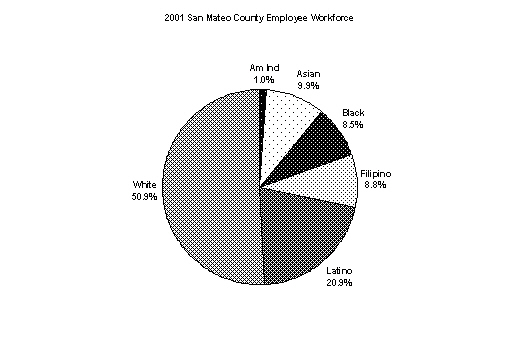
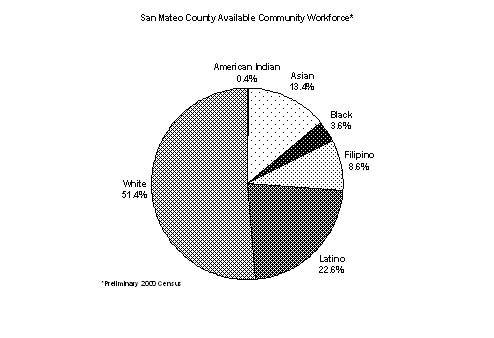 · The 2000 Preliminary Labor Force census data was used in determining available workforce representation for ethnicity and gender in preparing this report.
· The 2000 Preliminary Labor Force census data was used in determining available workforce representation for ethnicity and gender in preparing this report.
· The following section analyzes the County's progress in its efforts; compares the workforce from 1999 to 2001 by ethnicity, gender and occupational categories; and identifies areas of over and under-representation.
· The 2001 actual County combined minority employee workforce is 49.2%, exceeding the available community workforce of 48.6% by 0.6%.
· San Mateo County employee representation exceeds the available workforce for:
· San Mateo County continues to be under-represented for the following:
· Asian/Pacific Islander
· Latino/Hispanic
· White
· Male
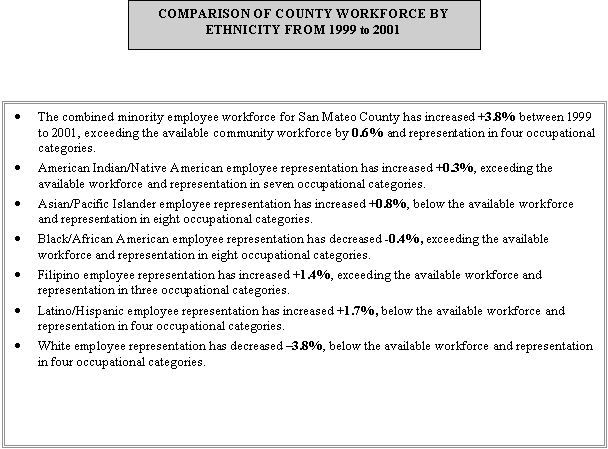
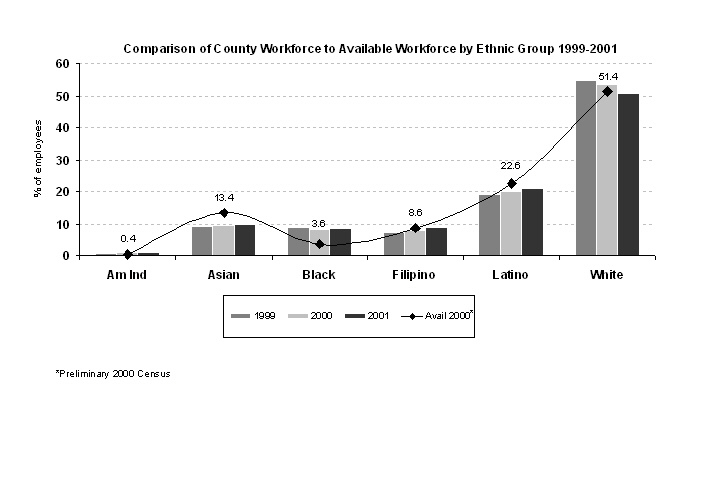
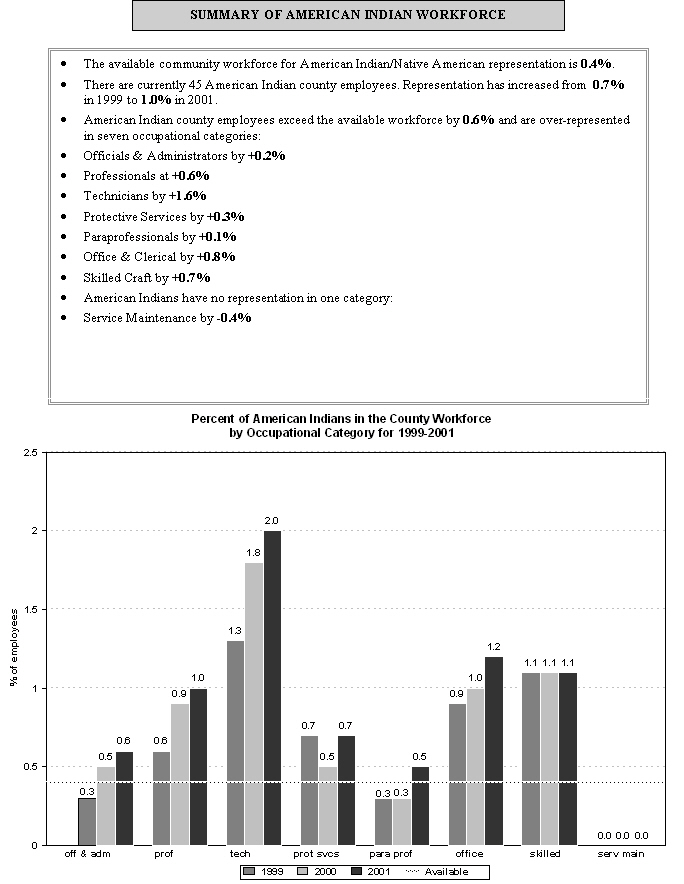
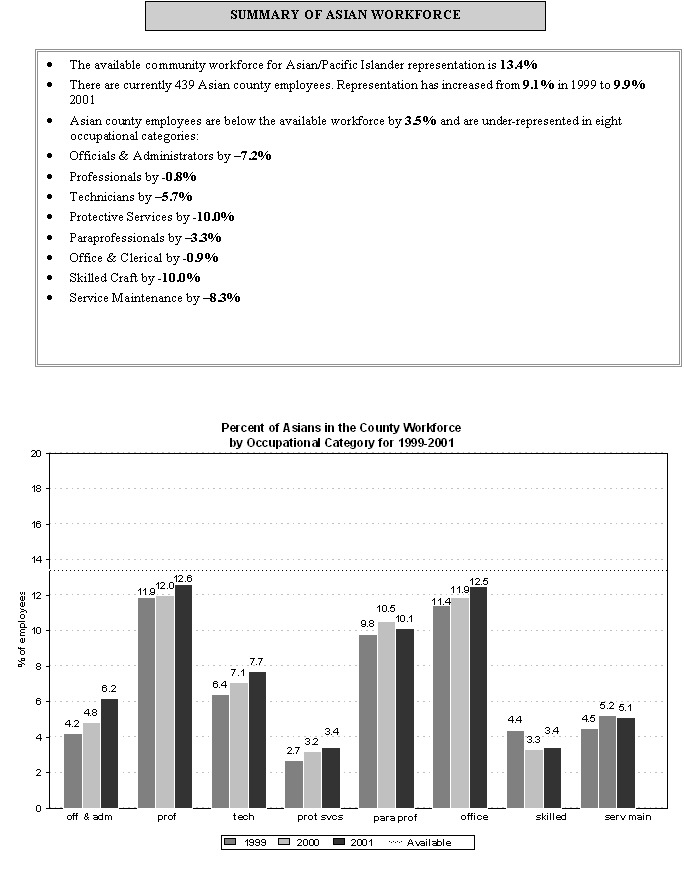
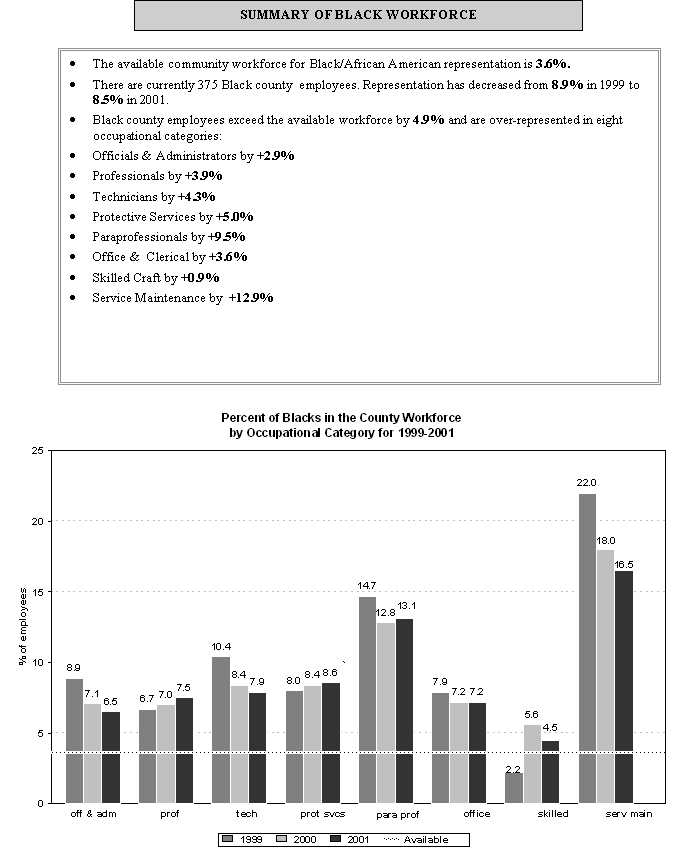
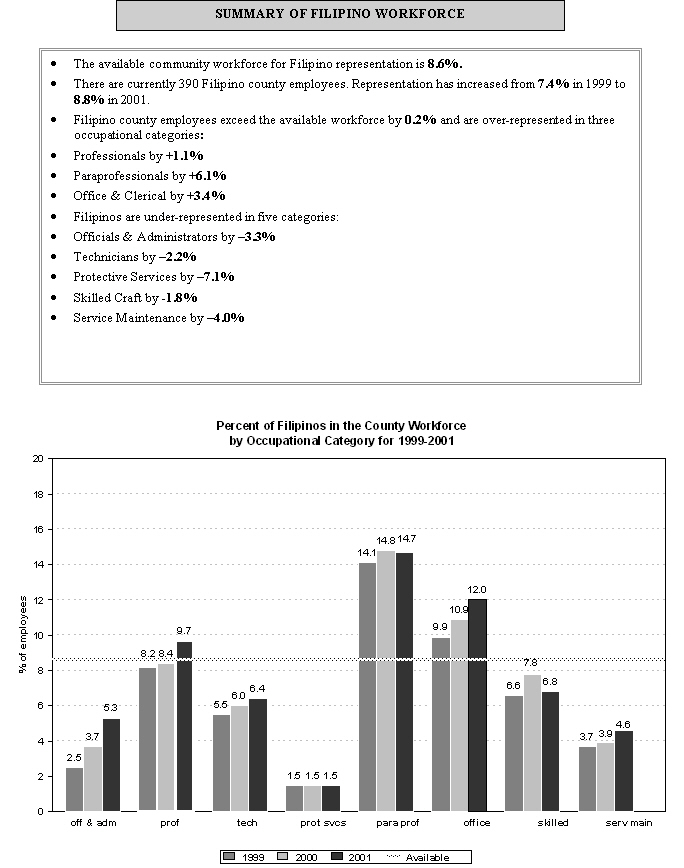
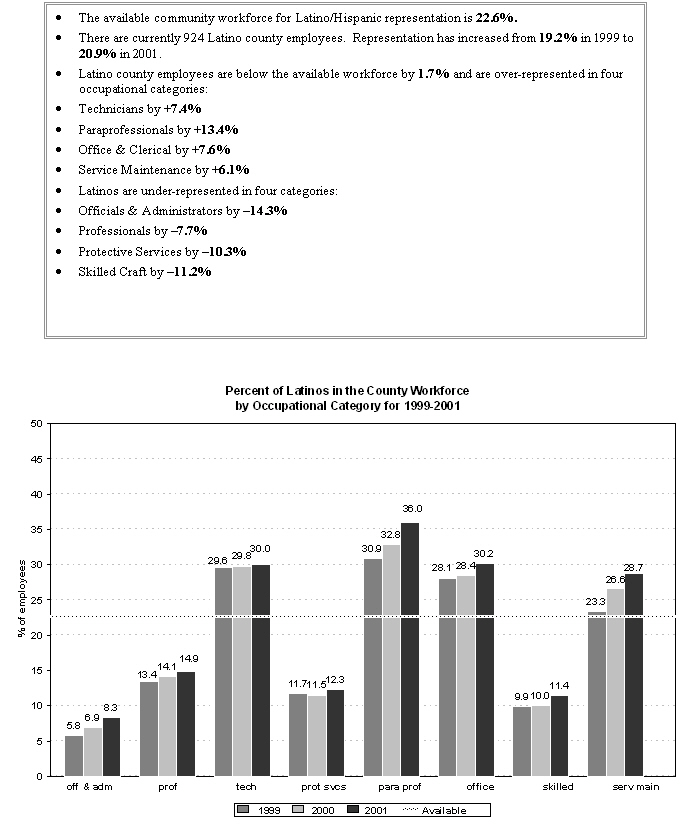
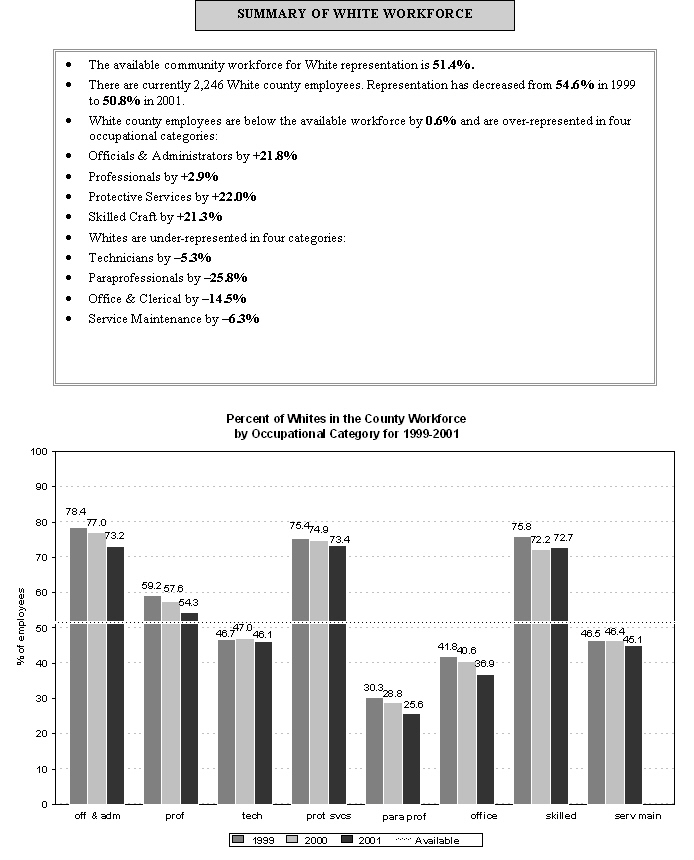
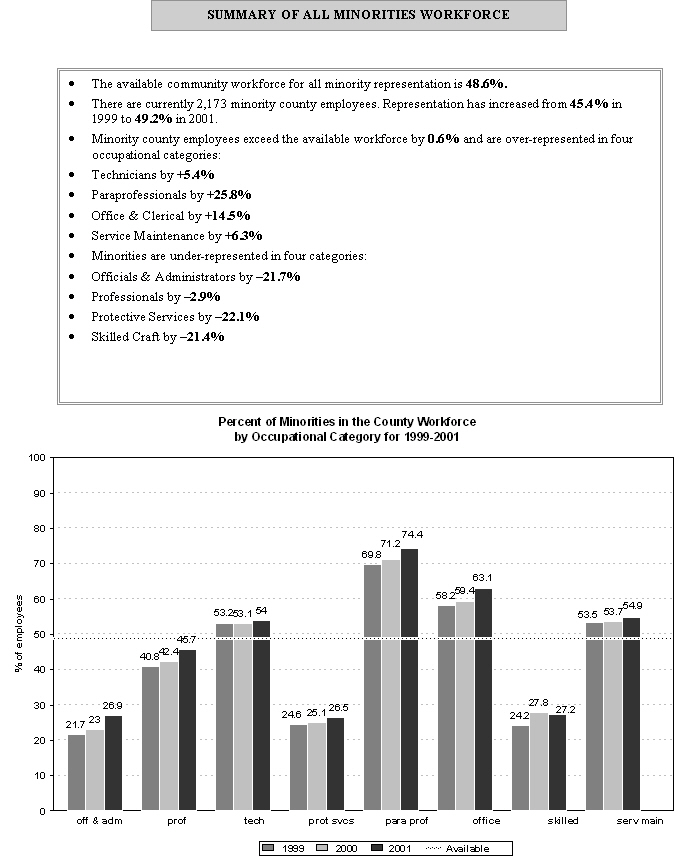
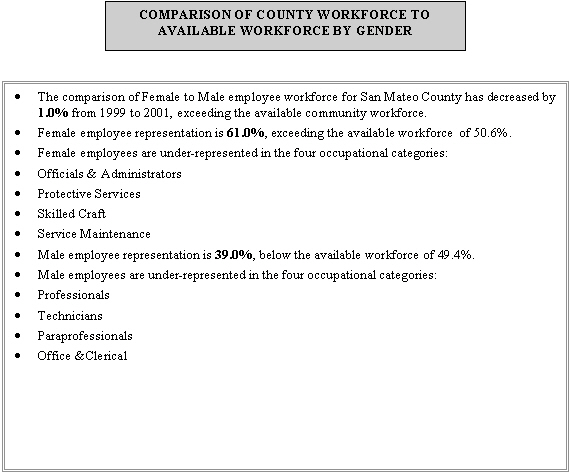
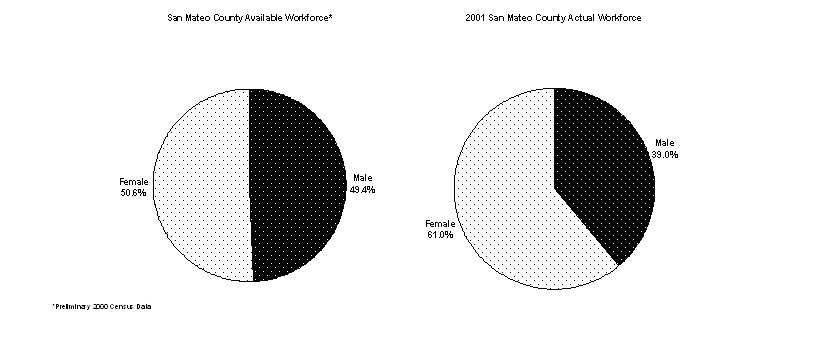
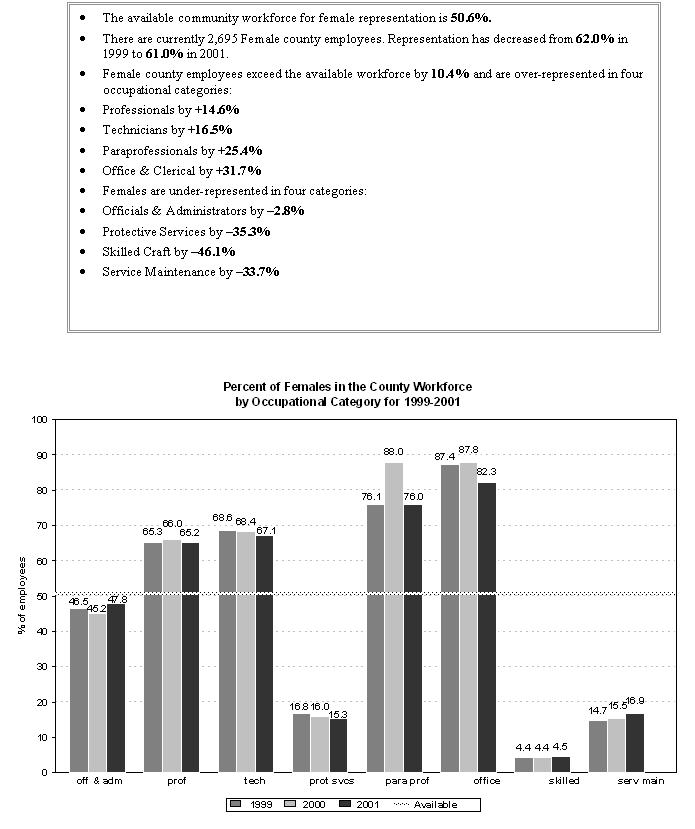
SUMMARY OF FEMALE WORKFORCE
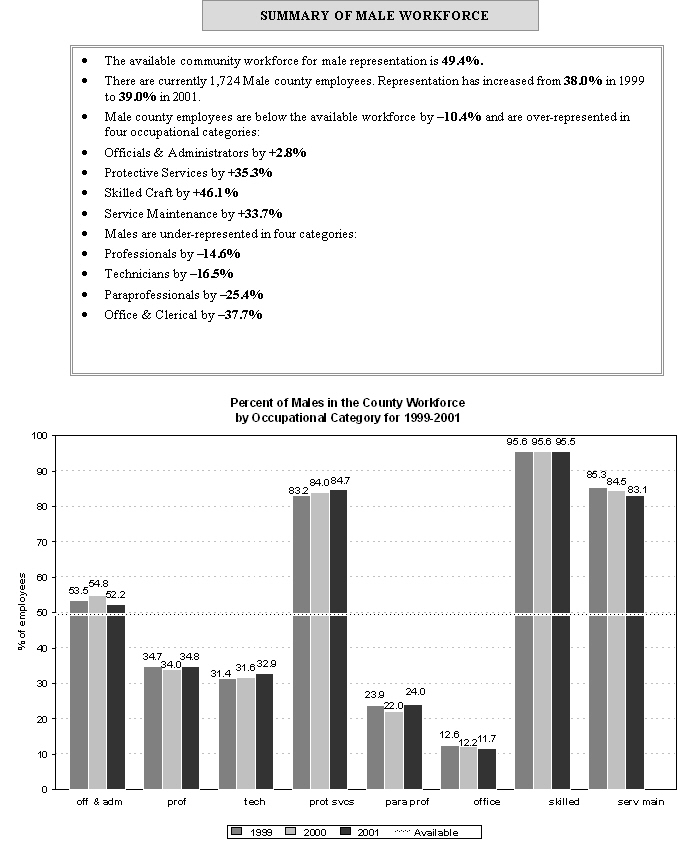
IV. ACCOMPLISHMENTS AND ACTION STEPS
|
Section IV-A: 2002-2005 ACCOMPLISHMENTS |
1. RECRUITMENT AND SELECTION
The County, in partnership with hiring departments, expanded outreach efforts to attract applicants that represent the community. Minority representation growth is consistent with the changing community demographics and has increased the County's ability to better serve customers.
Outreach efforts have been instituted to enhance recruitment efforts including on-line applications, Public Service Announcements, and the Employee Referral program.
In July 2001 Public Service Announcements were televised on Cable TV. County employees describe why they like working for the County and these TV spots have proven to be a useful recruitment tool.
Over the last several years the County has revised and updated the 653 classification specifications that describe County jobs, duties and qualifications. The project was completed in August 2001 and all classification specifications are now current and conform to federal and state laws.
2. TRAINING AND DIVERSITY
All new employees receive mandatory training on the County's non-discrimination, harassment and sexual harassment policies at the New Employee Welcome training.
In 1998 the non-discrimination policy was updated and distributed to every County employee including procedures on how to resolve or file a complaint.
Between 1999 and 2001 updated training on harassment and sexual harassment was provided to over 650 management and supervisory personnel and 1,700 line staff.
During 2000 and 2001 training on the American's with Disabilities Act was provided to 600 management and supervisory personnel.
New employees attend the Valuing Diversity training program to enhance understanding of ethnic, cultural, age, gender, sexual orientation, disabilities and other differences.
The EEO Advisory Committee sponsored a countywide Multicultural Faire with educational booths, Brown Bag seminars and an Awards and Recognition program.
3. CAREER DEVELOPMENT AND RETENTION
The Employee and Public Services Department and Women in Management co-sponsor an annual career development seminar to enhance professional skills and prepare employees for career development and promotional advancement.
On-site Associate, Masters and Bachelor's degree educational programs have been implemented for County employees.
Departments have demonstrated a commitment to internal development of employees through special (work out of class) assignments and enhanced training opportunities.
The EEO Advisory Committee conducted a survey of all managers and supervisors within the professional category of Officials and Administrators to evaluate successful career development strategies.
Section IV-B: 2002-2005 ACTION STEPS |
1. RECRUITMENT AND SELECTION
Expand outreach efforts to attract the most qualified candidates for employment who represent the diverse community we serve. Continued emphasis will be given towards attracting all under-represented groups to meet individual departmental needs.
Increase countywide efforts in order to achieve a broad candidate pool and balanced representation for EEO professional categories of Officials and Administrators, Protective Services, Skilled Craft and Office and Clerical through projects like the Career Opportunities Program.
2. TRAINING AND DIVERSITY
Develop and distribute a brochure and provide updated training to managers and supervisors on the Americans with Disabilities Act and work accommodations.
Evaluate the feasibility of providing mandated training for managers and employees on leadership development, management responsibilities, non-discrimination policies, and employee relations.
Develop and maintain a website for the 2002-2005 EEO Plan.
Publish periodic newsletters to all supervisors and managers informing them of changes in the EEO laws, provide tips on appropriate ways to handle EEO and ADA issues, and utilize case examples for guidance.
Offer the Valuing Diversity training program on a regular basis for newly hired employees.
3. CAREER DEVELOPMENT AND RETENTION
Analyze data from the management career survey and develop a report with recommendations.
Actively support the goals of the Career Opportunities Program through participation of EEO Advisory Committee members in partnership with departments.
Explore the feasibility of implementing the following Career Development and Retention programs: Formal coaching and mentoring, job swap on rotation, special assignments and pilot a succession planning program.
Section V-A: EEO ADVISORY COMMITTEE |
1. PURPOSE
The purpose of the Equal Employment Opportunity Advisory Committee is to advise and recommend courses of action to the Employee and Public Services Director and the County Manager regarding the effectiveness of the Equal Employment Opportunity Plan and its programs. The Committee is a resource group working to help the County Manager and the Employee and Public Services Director measure the progress made by the County and its organizations toward this end.
2. GUIDELINES
A. The Equal Employment Opportunity Advisory Committee will monitor, review, and make recommendations on all elements of the County's Equal Employment Opportunity Plan with respect to:
· Equal Employment Opportunity Programs developed or implemented by the County or its organizations.
· Proposed changes or modifications to the Equal Employment Opportunity Plan and its programs.
· Issues that relate to the successful implementation of the County's Equal Employment Opportunity Plan such as:
® Organizations and resources to administer an effective EEO Program
® Recruitment and retention
® Classification
® Selection and related personnel activities
® Upward mobility
® Program understanding and support
B. Equal Employment Opportunity Manager is under the direct supervision of the Employee and Public Services Department but as part of the regular duties, the Equal Employment Opportunity Manager will advise, confer, and assist the Committee in the process of carrying out its functions. The EEO Manager will provide staff assistance to include:
· Reporting to the Committee on developments regarding equal employment opportunity including, but not limited to, discrimination complaints, selection procedures, equal employment opportunity programs, changes in laws, County employment, and employment and training programs.
· Report on the equal employment opportunity activity including, but not limited to accomplishments and objectives.
· Assist the Committee in the formulation of its annual report to the County Manager. The report will be brief and its intent will be to inform County management of the progress of equal employment opportunities and affirmative action.
C. The Committee may make recommendations regarding changes in State law, County Administrative Code, Civil Service Rules, or other regulations that may hinder the achievement of the objectives.
D. The Committee may make suggestions and recommendations regarding the utilization of employment and training programs and federal, state, or County funds that may help further this Plan or its programs.
E. Limitations of Committee:
· Appointed to assess and to advise, but not to operate any elements of County government.
· Review goals and assess the progress of the Equal Employment Opportunity Plans of any County organization, but the ultimate responsibility for setting and obtaining goals and objectives lies with each department head.
· Expected to work within the framework of County government.
F. Committee Composition: The Committee will consist of no more than 15 members appointed by the County Manager, and 3 liaisons as follows:
® Commission on the Status of Women
® Civil Service Commission
® Commission on Disabilities
· The Committee shall nominate its own Chairperson and Vice-Chairperson biannually in the month of December.
· The Committee members will serve at the discretion of the County Manager. Term of office will normally run from January 1 to December 31. In the event of a vacancy for any reason, the County Manager will make appointments to fill the unexpired term and consider the recommendations made by the Committee.
· All regular meetings will be held bimonthly on the second Thursday of the month at 10:30 a.m. Special meetings may be scheduled as required.
· When a Committee member is absent for three (3) consecutive meetings (unexcused), the seat shall become vacant and the incumbent be deemed to have automatically resigned.
Section V-B: EEO OCCUPATIONAL JOB CATEGORIES |
Officials and Administrators: Occupations in which employees set broad policies, exercise overall responsibility for execution of these policies, or direct individual departments or special phases of the agency's operations, or provide specialized consultation on a regional, district, or area basis. Includes: department heads, division chiefs, directors, deputy directors, controllers, Judges, sheriffs, captains, inspectors, building inspectors, assessors, labor relations workers, tax appraisers, investigators, coroners, program managers, and health services managers.
Professionals: Occupations that require specialized and theoretical knowledge which is usually acquired through college training or work experience and other training that provides comparable knowledge. Includes: personnel, social workers, probation officers, doctors, psychologists, registered nurses, dieticians, lawyers, system analysts, accountants, engineers, employment and vocational rehabilitation counselors, teachers or instructors, Sheriff's captains and lieutenants, librarians, and management analysts.
Technicians: Occupations that require a combination of basic scientific or technical knowledge and manual skill which can be obtained through specialized post-secondary school education or equivalent on-the-job training. Includes: computer programmers, drafters, surveyors, licensed practical nurses, technical illustrators, technicians (medical, dental, electronic, physical sciences), benefits analysts, communications dispatchers, family support officers, and park rangers.
Protective Service Workers: Occupations in which workers are entrusted with public safety, security, and protection from destructive forces. Includes: deputy sheriffs, bailiffs, correctional officers, sergeants and lieutenants , harbor patrol officers, wardens, and district attorney inspectors.
Paraprofessionals: Occupations in which workers perform some of the duties of a professional or technician in a supportive role that usually require less formal training and/or experience normally required for professional or technical status. Such positions may fall within an identified pattern of staff development and promotion under a "New Careers" concept. Includes: research assistants, medical aids, community workers, shelter care counselors, library assistants, licensed vocational nurses, food service workers, and medical service assistants.
Administrative Support (including Clerical and Sales): Occupations in which workers are responsible for internal and external communication, recording and retrieval of data and/or information, and other paperwork required in an office. Includes: administrative secretaries, fiscal office assistants, clerk-typists, court transcribers, payroll clerks, office machine and computer operators, telephone operators, legal assistants, mail services driver, cashiers, medical office assistants and patient services attendants.
Skilled Craft Workers: Occupations in which workers perform jobs that require special manual skill and a thorough and comprehensive knowledge of the processes involved in the work which is acquired through on-the-job training and experience or apprenticeship or other formal training programs. Includes: auto mechanics and repairers, electricians, heavy equipment operators, stationary engineers, painters, skilled machining occupations, and carpenters.
Service-Maintenance: Occupations in which workers perform duties that result in or contribute to the comfort, convenience, hygiene or safety of the general public or that contribute to the upkeep and care of buildings, facilities, or grounds of public property. Workers in this group may operate machinery. Includes: bus drivers, transportation drivers, custodians, utility workers, construction laborers, park rangers (maintenance), and craft apprentices/trainees/ helpers.
Section V-C: GLOSSARY OF EEO TERMINOLOGY |
Adverse Impact or Adverse Effect: The showing that an employment practice, procedure, or test has hampered the employment opportunity of one or more members of a protected group.
Affected Class: Members of an applicant group who, by virtue of past discrimination, continue to suffer the present effects of that discrimination.
Applicant Flow Analysis: A statistical analysis conducted to determine if any portion of the examination process is having an adverse impact upon protected group members.
Artificial Barriers: Requirements, procedures, or standards for employment that are not related to successful job performance.
Auxiliary Aides and Services: To include qualified interpreters or other effective methods of making aurally delivered materials available to those with hearing impairments; qualified readers, taped text or other effective methods of making visual materials available to those with visual impairments; acquisition or modification of equipment or devices, or other similar services and actions.
Bona Fide Occupational Qualification (BFOQ): A situation where a member of only one protected group is appropriate in an occupation because of function, authenticity, or genuineness or as required by law.
Criteria: Quantifiable measures of job performance or success, as indicated in supervisor's ratings or training evaluations.
Disability: A person who has a physical or mental impairment that limits one or more major life activities, has a record of such an impairment, or is regarded as having such an impairment.
Discrimination: The showing that a practice, procedure, or test has an adverse effect on at least one protected group and is not job related.
Disparate Treatment: When members of a protected group have been denied the same employment, promotion, transfer, benefits, or membership opportunities that have been made available to other employees or applicants.
Equal Employment Opportunity: A condition under which all employment practices including selection, transfer, promotion, termination, compensation, and other benefits are implemented on the basis of valid, job-related requirements without regard to race, creed, national origin, color, religion, age, physical handicap, sex, or sexual orientation.
Job-Related Qualifications: Requirements that are realistically related to the actual duties of the job. These requirements consist of the actual knowledge and skills required to perform those duties determined by a thorough job analysis.
Merit Systems: Selection of persons for employment based on ability.
Protected Group: Groups protected against discrimination by law or policy. These groups include, but are not limited to, race, sex, sexual orientation, national origin, religion, physical handicap, and age.
Selection Device: Tests, educational and work history data, interviews, and other tools to determine relative levels of job qualifications.
Validity: The extent to which a selection procedure samples the content of the job. Theoretically, a valid selection procedure is predictive of job success.

Printed By:
Employee and Public Services'
Copy Center
![]()


 · The 2000 Preliminary Labor Force census data was used in determining available workforce representation for ethnicity and gender in preparing this report.
· The 2000 Preliminary Labor Force census data was used in determining available workforce representation for ethnicity and gender in preparing this report.












